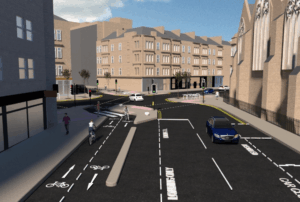Cheshire East Council has completed the Wilmslow cycleway, with the opening of a new section of the route between Wilmslow and Nansmoss Lane, Morley Green.
The new route is a traffic-free, segregated cycle lane running alongside the busy A538 Altrincham Road.
An uninterrupted journey, by cycle or on foot, is now possible between Wilmslow and Manchester Airport, without having to travel on the busy A road. The work was not possible until all the land needed for the link had been acquired.
The new route also provides safer and easier pedestrian access to the Bollin Valley, and a traffic-free cycleway all the way to Manchester Airport and its business parks for work, and to the Waters site, near Wilmslow.
Councillor Craig Browne, Cheshire East Council deputy leader and chair of the council’s highways and transport committee, said: “Providing more opportunities for people to cycle safely is a key part of the council’s agenda to encourage active and sustainable travel, as well as helping to improve health and wellbeing.
“Completion of this particular cycle route complements other cycle and walking routes in Wilmslow, including the 1.5mile link between the train station, Wilmslow High School, Alderley Park and other business centres.”
The borough’s cycling and walking champion, Councillor Suzie Akers-Smith, said: “This is excellent news, and I am so pleased that our highways service has completed this ‘missing link’ in a cycle route that gives people the choice to use more sustainable and healthy forms of transport and benefit from improved links to employment sites and the Cheshire countryside in this part of the borough.”
Rob Sharpe, from Cycle Wilmslow, said: “We are delighted this route has come to fruition. It is a significant improvement for sustainable transport on a key route in and out of Wilmslow. And it will improve safety for cyclists and pedestrians on a very busy route.”
The three-metre-wide link was constructed in just two months and funded through government grant for active travel schemes. It’s hoped active travel routes and segregated cycleways will encourage more residents, where possible, to cycle or walk and adopt more sustainable forms of transport.






















